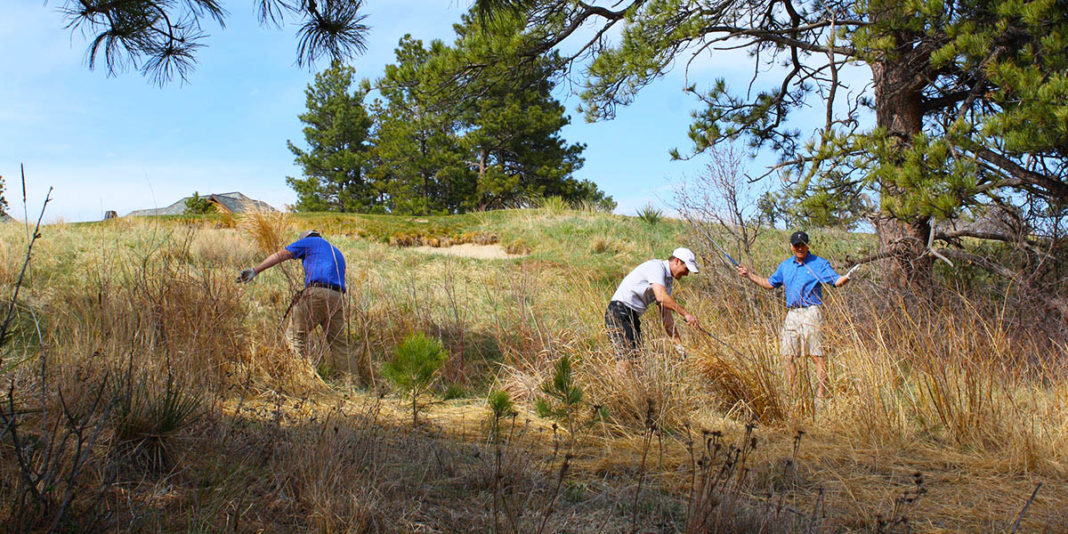Learn truth vs. common fiction in golf … Chapter 2: Misunderstood Golf Rules
By Jon Levy
Our series, Golf Myths DEBUNKED, *finally* puts an end to those longstanding debates you and your buddies can’t settle when it comes to fact vs. fiction in golf. We periodically shed light on five myths that have commonly, and incorrectly, become the standard for most of the golfing world.
In Chapter 1, we covered various topics that many golfers think are truths within the game. And, as we unveiled after a little fact-checking, myth vs. reality turned out to be drastically different.
We’re back with Chapter 2 to explore five commonly misunderstood golf rules that can be confusing for many. So read on, get enlightened, and share with a friend who could use this information!
Chapter 2: Misunderstood Golf Rules
1. Out of Bounds vs. Ball Lost vs. … what you do
Here’s a quick breakdown of the three:
Out of Bounds: If your shot comes to rest on the wrong side of the white stakes, you’re required to play another from the same spot under the penalty of Stroke and Distance. It’s commonly thought an O.B. ball incurs a two-stroke penalty, which, in essence it does. But think of it as a one-shot penalty plus another stroke played from where you just hit. This replayed shot basically erases any “distance” the O.B. shot may have gained, thus taking the essence of a two-stroke penalty.
Also, whether you know your shot went O.B. or just think it could be, USGA Rule 27 calls for declaring a Provisional Ball. This is the name for your do-over effort. The provisional becomes in play if the original shot is deemed out of bounds, and disregarded if it’s in. Either way, you should always hit a provisional before leaving the area to keep up speed of play.

Ball Lost: Similar to the out-of-bounds ball, it’s wise to hit a provisional anytime there’s a chance you may not find it. USGA Rule 27 also states you have 5 minutes to identify your ball once you start searching. If the ball is not found, your provisional is in play under the same stroke-and-distance penalty as the O.B. ball.
What YOU do: OK, maybe you don’t do this, but someone you know does. What we’re talking about is flailing one O.B. or into the woods, and then dropping the ball – taking only a one-stroke penalty – in an area near where it entered Troubleville. This unofficial amendment of the rule not only creates an arbitrary dropping point, but virtually eliminates the “distance” part of intended penalty and saves a shot from your score.
PSA: Now that you know this, if you – sorry, your “buddies” – still don’t hit provisionals and drop per the usual with O.B. and lost balls, at least add TWO onto your score to more accurately reflect.
*Check out THIS video from the USGA for more information on out-of-bounds and lost ball procedures.
2. Relief from a cart path
No, you cannot drop the ball on whichever side of the path gives the best shot to the green on your next. Yes, you are guilty of this at one time or another.
USGA Rule 24-2 basically explains that free relief is given from immovable obstructions, which are artificial objects like cart paths, sprinkler heads, signs, etc. But most golfers already know that. The real fun happens in many players’ adaptations of the rule regarding where they take their relief.
Here’s a snazzy chart from the USGA explaining further:
So, yes, this means that, sometimes, the open and inviting fairway on one side of the path with a clear shot to the green is NOT where you’re allowed to drop. The only entitled relief may instead be on that other side of the path, which isn’t as favorable to your cause.
Keep in mind you can always play the shot from the path as it lies, which we’ve seen more than once on the PGA Tour. Check out Phil Mickelson illustrating this point below, with one of his many instances of short game magic:
*Check out THIS video from the USGA for more information about relief situations.
3. The difference between Red and Yellow water hazards
 This one stumps a lot of golfers. Here are two ways to simplify differences between each:
This one stumps a lot of golfers. Here are two ways to simplify differences between each:
- Yellow stakes indicate a Water Hazard, which is generally an obstacle the hole’s intended design requires you to carry. Red stakes indicate Lateral Water Hazard, which is more auxiliary to the hole (hence, “lateral”) and often take the form of creeks or lakes/marshy areas on the sides of the fairway.
- When your ball comes to rest within a yellow-staked area, you have three options to proceed. When in a red-staked area, you have five.
The three options when in a water hazard (yellow) are as follows:
- Play the ball as it lies, without penalty
- Play a ball from the same spot where your last shot was played, taking a one-stroke penalty
- Drop a ball any distance behind the hazard, keeping a straight line between the hole and the point where the ball last crossed into the hazard, and take a one-stroke penalty
Here’s another nifty graphic from the USGA on the additional two options in a lateral water hazard (red):

Still a little murky on water hazards? You’re not alone.
Even at the game’s highest level – most famously so with Tiger Woods at the 2013 Masters as shown below in the Associated Press’ recap of his controversy on No. 15 – the correct procedures surrounding water hazards still cause confusion.
*Check out THIS video from the USGA for more information about water hazards.
4. Does a golfer playing from off of the green always hit first, regardless if his or her playing partner on the green is farther away?
No. Here’s USGA Rule 10 if you want to dig into it, but long story short, whichever golfer is farthest away from the hole plays first. It doesn’t matter whether he or she is on the putting surface or not.
The only thing you really need to remember, though, has to do with speeding up play. Or, basically this: The golfer who is ready to play first, should always play first!
*Check out THIS resource from the USGA about for more information about order of play.
5. The proper way to drop a golf ball
Let’s refer back to TW in 2013. Notice his form below – arm extended, ball dropped from shoulder height straight down with no added force or intention, an anxious look from caddie, Joe LaCava, who was likely wondering if his player’s drop and ensuing shots would lead to another Masters title (it didn’t) – yes, even though the subject of where Tiger dropped the ball was in question, his form doing so was perfect.

USGA Rule 20 covers the full monty on dropping a golf ball, but if you just want to know the basics, copy Tiger’s form as shown above.
*Check out THIS resource from the USGA for more information about how to properly drop a golf ball.
Postlude: One golfer’s statement about the USGA Rules of Golf
While incredibly complex, far-reaching and written in a book that reads akin to the U.S. Constitution at best, the official USGA Rules of Golf were created to govern the confines of golf in a manner guided by the following, as written in the book’s Foreword:
The historical principles and ethos of the game, the need for the Rules to remain clear, comprehensive, appropriate and relevant, and the importance of ensuring that golf is played with integrity and in accordance with etiquette.
The reality in golf is that the majority who play it (somewhat) strive to follow the rules. But, aside from competitive golf, where rules are followed to the letter, many golfers incorporate a relaxed, generalized version of the rules when they play.
And that’s OK. Golf should, and NEEDS, to remain fun at all costs. Because, considering the complex nature of golf’s rules, it can be tough (and too slow) for John Q Golfer to follow all of them as fully intended. Regardless, it’s good to know the rules of golf whether you choose to abide by them or not.
No matter the case, though, (and regardless of your stance on the complicated nature of golf’s rules, which has become politicized), we should all play golf how it best suits each one of us, and our enjoyment of the game.
Because – again – golf should, and NEEDS, to remain fun at all costs.












This explanation of Out of Bounce is easy to understand and it is logical. I had a similar type of situation in a tournament I was playing but not sure if the ruling was done correctly. Ruling was that it is not out of bounce. Let me briefly describe the situation and help me understand if the ruling was correct. The ball rested between two white stakes probably 40 feet apart. Both stakes were not in straight line and there was curb built with bricks 2-3 inches in height. The ball stopped outside edge of the nearest white stake touching the curb if you look at the nearest white stake but it looked like the ball was inside if you look at from the other white stake. So was the ruling correct?